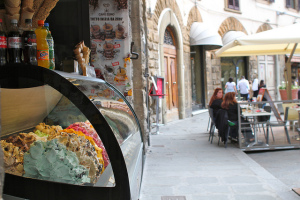Finding Mrs. Perfect In Italy – The Cross-Cultural Dating Scene
Posted on August 24th, 2014 by Anna in Uncategorized | No Comments »
 Whether you come from an Italian background or are a newcomer to Italian culture and customs, you surely know that Italy is synonymous with romance in most mindsets. And while it is not an uncommon practice for second-generation Italians to travel to their family’s native sod to seek out and marry “a nice Italian girl,” they find themselves sorely unprepared for the dating scene and the expectations held by Italian women. And, while English-speaking cultures tend to be more egalitarian when it comes to gender relations, Italy prefers a more chivalrous approach, with the women traditionally being pampered, flattered, and showered with gifts. Italian men have such a finely honed game, with their custom-tailored Armani suits and their mellifluous chat-up lines, that even the most well-intentioned of foreigners find it hard to compete. But if you mean to try, here are a few tips to follow.
Whether you come from an Italian background or are a newcomer to Italian culture and customs, you surely know that Italy is synonymous with romance in most mindsets. And while it is not an uncommon practice for second-generation Italians to travel to their family’s native sod to seek out and marry “a nice Italian girl,” they find themselves sorely unprepared for the dating scene and the expectations held by Italian women. And, while English-speaking cultures tend to be more egalitarian when it comes to gender relations, Italy prefers a more chivalrous approach, with the women traditionally being pampered, flattered, and showered with gifts. Italian men have such a finely honed game, with their custom-tailored Armani suits and their mellifluous chat-up lines, that even the most well-intentioned of foreigners find it hard to compete. But if you mean to try, here are a few tips to follow.
1. Don’t try to be Italian. You will come off as a sad mockery at best if you try the typical Casanova approach to wooing. Rather than overblown compliments and declarations of love that will sound tacky and forced coming from an expat who is already out of his element, determine your own best qualities and play them up as best you can.
2. Free Your Emotional Side. Italians are known for being passionate and spontaneous, so coming out into the Italian social scene can be a fun chance to explore these sides of yourself in a way you may not have before. Spur of the moment romantic gestures, public shouting, fast driving, and fits of jealousy are generally viewed as signs of appreciation.
3. Always Be Well-Dressed. It’s a sign of class and self-respect to wear brand-name suits in Italy, and while they don’t necessarily have to be expensive, it’s best to wear subtly elegant clothes at all times. Pay attention to matching colors and patterns, as well as shoes and accessories. This goes double for grooming and personal hygiene.
4. Walk Through the Door First. This may seem counter-intuitive, as in English-speaking countries it’s considered polite for a man to open a door for a woman and let her walk through first. However, in Italy this dates back to a custom of entering a building and scoping it out to make sure it’s free from brigands and thus safe for your lady-friend. Today the custom endures as a sign of respect.
 5. Use Your Foreignness To Your Advantage. As an outsider, you are automatically intriguing to local women, and that can be a good way to say hello and spark conversation. Many women who are tired of the melodramatic charade that is dating an Italian man will actually find you a breath of fresh air if you treat her with honesty and loyalty. Express curiosity in her culture, family, and language—if you conduct yourself in a sincere and pleasant fashion, she’ll be all too happy to agree to meet up with you again. Get started by sending us an inquiry, and take a look at our different levels of Italian courses.
5. Use Your Foreignness To Your Advantage. As an outsider, you are automatically intriguing to local women, and that can be a good way to say hello and spark conversation. Many women who are tired of the melodramatic charade that is dating an Italian man will actually find you a breath of fresh air if you treat her with honesty and loyalty. Express curiosity in her culture, family, and language—if you conduct yourself in a sincere and pleasant fashion, she’ll be all too happy to agree to meet up with you again. Get started by sending us an inquiry, and take a look at our different levels of Italian courses.


 For one thing, Italy’s contribution to the world of cookies and biscuits is seemingly endless. Everyone has probably had biscotti with their coffee at Starbucks, but there are also pizzelles, a thin, waffle-like cookie with a lacy pattern, flavored with anise, vanilla, or almond extract. The Prado-based cookies brutti ma buoni (which translates to “ugly but good,”) look like unappetizing stones, but have a delicate almond flavor. The Florentine is a particularly elaborate concoction: a caramel disc coated with dark chocolate, chopped hazelnuts and almonds, and candied cherries.
For one thing, Italy’s contribution to the world of cookies and biscuits is seemingly endless. Everyone has probably had biscotti with their coffee at Starbucks, but there are also pizzelles, a thin, waffle-like cookie with a lacy pattern, flavored with anise, vanilla, or almond extract. The Prado-based cookies brutti ma buoni (which translates to “ugly but good,”) look like unappetizing stones, but have a delicate almond flavor. The Florentine is a particularly elaborate concoction: a caramel disc coated with dark chocolate, chopped hazelnuts and almonds, and candied cherries.

